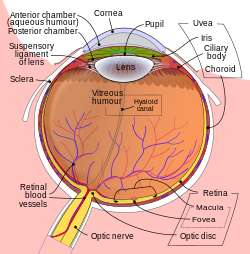Our website is made possible by displaying online advertisements to our visitors.
Please consider supporting us by disabling your ad blocker.
Pupil (eye)


The pupil is the opening in the centre of the eye. Light enters through the pupil and goes through the lens, which focuses the image on the retina.[1]
The size of the pupil is controlled by muscles. There is a circular group, which squeezes the iris smaller, and another group which pulls the iris wider. When more light is needed, the pupil is made larger. In brighter light, the pupil is made smaller. The pupil can be compared with the aperture of a camera. It is surrounded by the iris which is the colored part of the eye.
The lens changes its shape depending on how far away the eye focuses. The focus point is where the eye is focusing on. The light makes the pupil change its size. When it is darker, the pupils will dilate (get bigger) because they need to allow more light into the eye to see. When it is bright, the pupil will constrict (get smaller) to restrict the amount of light there is getting into the eye so we can see. The pupil is normally black in most animals, but in some reptiles, it can be a different colour.
The main reason why we have a pupil is to regulate the light which travels to the retina. The reason why it has no colour is because the light that travels through the pupil is absorbed by the tissues in the inside of the eye. In humans, the pupil is round, but in some other animals, like cats, it is shaped like a slit.[2]
- ↑ Cassin, B. and Solomon, S. Dictionary of Eye Terminology. Gainesville, Florida: Triad Publishing Company, 1990.
- ↑ Malmström T, Kröger RH (January 2006). "Pupil shapes and lens optics in the eyes of terrestrial vertebrates". J. Exp. Biol. 209 (Pt 1): 18–25. doi:10.1242/jeb.01959. PMID 16354774. S2CID 336280.
Previous Page Next Page


